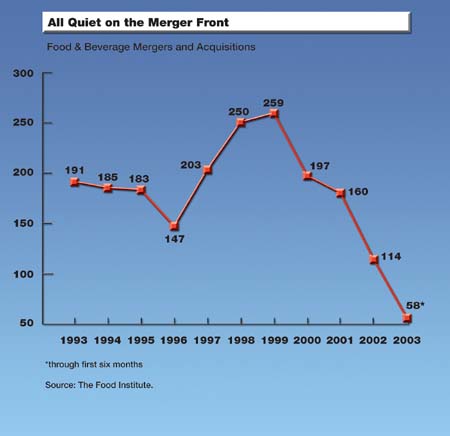
From the investment community's perspective, the food industry is the redheaded stepchild: unwanted, unloved and under performing in the stock portfolio. Alan Greenspan's musings on marginalized American manufacturing undoubtedly found a sympathetic ear with this crowd.
Yet 2002 sales at some of the leading food and beverage companies advanced a solid 3.74 percent last year, and 2003 is shaping up as another stellar year (see chart).

Extra cash on hand is having a positive impact on capital spending plans. A year ago, 2002 budgets at the 32 food and beverage companies were pegged at slightly less than 1 percent (see chart). Instead, spending increased 12 percent, with Unilever, Smucker and ADM leading the charge toward higher-than-expected investments.
Based on Food Engineering's annual State of Food Manufacturing Survey, capital investments in plants remain strong, though increases have slowed compared to last year's blistering pace. Almost three in 10 respondents to this year's survey have more money to spend on production, packaging and process-control equipment than last year, down from 36 percent in 2002. Conversely, more facilities have seen their budgets slashed this year, and the spending knife is cutting deeper for those dealing with retrenchment.
Budget boosts for plant improvements and upgrades, process control hardware and software and maintenance-related automation also are more modest. Almost a third of survey respondents report that spending on plant improvements and upgrades is increasing, while one in five are coping with cutbacks. But belt tightening is occurring in the context of the free-spending days of the recent past.
Growth in maintenance and equipment spending may be slowing, but companies are putting a larger share of facility budgets into the systems and machines needed to optimize those plants while holding infrastructure investments at an even rate.
Envy of manufacturing
In the manufacturing galaxy, food's star shines bright. The Institute for Supply Management's (ISM) mid-year forecast for U.S. manufacturing ranks the food sector as the third most-optimistic sector in terms of 2003 revenue growth expectations. The two sectors ahead of it are paper and chemicals, manufacturing basketcases in recent years that can only go up. Overall, U.S. manufacturers anticipate 1.9 percent revenue growth this year. If the publicly held companies in Food Engineering's sample are any indication, food and beverage firms will lap the field.Food manufacturers are operating at capacities above 80 percent, the ISM's threshold for increased capital investment. Purchasing and supply executives told ISM food manufacturers would increase their capacity more than 2 percent this year. Food Engineering readers concur, with two out of five expecting output to increase over 6 percent at their facilities and almost one in five forecasting increases up to 6 percent (see chart on page 54).
To meet those production challenges, food professionals are investigating additional automation opportunities, a need that is second only to food safety, according to Food Engineering readers. Many respondents are scrambling to meet the demands of increased sales, and more automated systems are seen as the best way to do that. "Manpower is our main limiting bottleneck," one reader wrote. "Much more automation is needed."
Process controls and automated equipment are getting a bigger share of the plant budget. Integration of those systems with the rest of the enterprise is where many readers see the greatest need. Better communication between marketing and production was cited as a great need by a quarter of respondents, and better integration of the plant floor with sales and forecasting is a high priority with one in five. Data communication is essential if processors are to "meet customer needs in a timely fashion," one respondent wrote.

Half of the survey respondents say their companies are doing little or nothing to make supply chain integration a reality. Almost a quarter are using EDI for order-capture and invoicing, and almost as many have implemented some supply chain software (14.3 percent will purchase integration software this year). Only 18 percent are letting their customers check order status on the Web, and even fewer are making use of that communication option with suppliers.

For the first time, readers were asked what measures have been taken to improve security in their plants. Increased screening of plant personnel was cited by three out of five, with only slightly fewer indicating stricter oversight of the people and companies that handle their finished goods was being done. Two out of five companies are auditing their suppliers' security measures, and 29.5 percent have turned to tamper-evident packaging. Specific steps focus on much tighter control of building access, with keycard doors, guards, perimeter fencing and closed circuit cameras being deployed.
Asked where the gaps are in the manufacturing mission, insufficient integration within the organization and with business partners was mentioned almost as frequently as the lack of skilled workers to run increasingly automated plants. "We are very conservative with funds and tend to sometimes wait too long to make changes," one reader lamented.

Programmable logic controllers remain the computerization tool of choice in food plants. Seven out of 10 respondents will add to their PLC arsenals this year. The next most popular hardware/software purchase is predictive maintenance software (26.4%). Interest in HMI systems dropped to one in five, down from 30% in last year's survey. Preventive maintenance software is on the shopping lists of one in four plants.
While food professionals are well aware of the automation imperative, they also recognize the increased demands placed on personnel. Better skills training of both line operators and supervisors emerged as the top two needs at respondents' facilities, outpacing line flexibility, better maintenance and other concerns that often get more focus.


